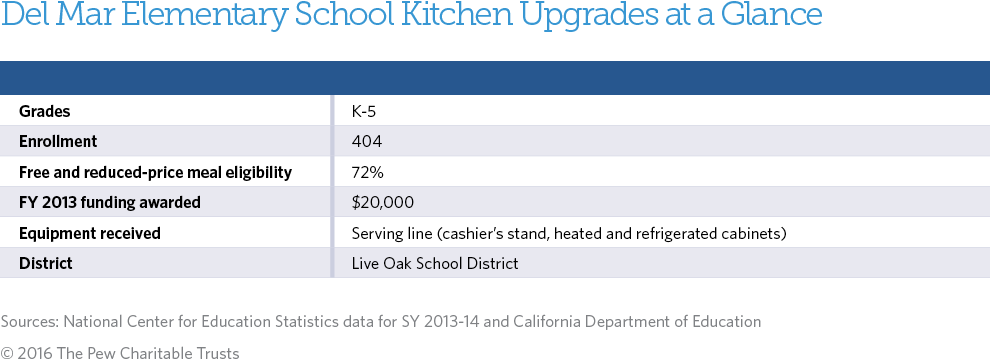Del Mar Elementary School
Santa Cruz, California
Santa Cruz County, on California’s central coast, is a rich agricultural region producing a diverse array of fruits and vegetables. But unfortunately for the students at Del Mar Elementary School, the appeal of these fresh foods was not reflected in their cafeteria until three years ago, simply because the school lacked the proper serving and display equipment. To solve this problem, Del Mar used a U.S. Department of Agriculture grant to purchase a new serving line.
Before the upgrade, a collection of mismatched pieces of equipment sat against a dimly lit wall, gloomily displaying food for children to select. Because both the equipment and the available cafeteria space were so small, fruits and vegetables were often piled into buckets on one of the units, making them look as unappealing as the 25-year-old equipment they were sitting on.
“Three-quarters of the students here at Del Mar qualify for free and reduced-priced meals, which means they might not be exposed to fresh fruits and vegetables at home. We wanted to prioritize making those foods accessible and appealing to them at school,” said Rachel Otis, food service director for the Live Oak School District.

Today, the updated equipment allows the school to serve fresh, local produce in an attractive way and to spur students to try new, healthier menu items. The new serving line includes chilled and heated cabinets so foods can be stored at safe temperatures and displayed in the most efficient ways. And its stainless steel frames let meal program staff serve breakfasts and lunches “buffet style,” which is more visually appealing, maintains better quality, and results in less waste than the individually wrapped portions the school used to offer.
Since the school added the new serving line, program participation has grown. Kids enjoy being able to see and smell the foods on display, instead of choosing a plastic-wrapped option from a pile.
“Meal counts have increased due to the new serving line because students like coming in to get lunch,” Otis said. “Students have also grown to accept more fresh fruits and vegetables—it’s amazing how serving these items chilled can make them so much more appealing to the kids.”
Reduced prep time and staff labor is another benefit of the new equipment. Chicken potpie, a popular entree, previously required employees to carry individual items from a holding cabinet to the serving line. Now, staff can place whole trays of potpies into the serving line. And as an added bonus, the school no longer experiences blown breakers during mealtime because the new equipment is much more energy-efficient than the old units.


USDA’s School Kitchen Grants Benefit Meal Programs and Students
The right equipment makes a difference in efficient...
Learn More

School Nutrition Gets a Boost From USDA Kitchen Equipment Grants
School Nutrition Gets a Boost From USDA Kitchen Equipment Grants
Learn More





